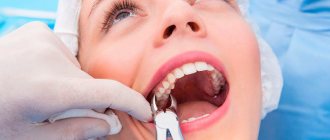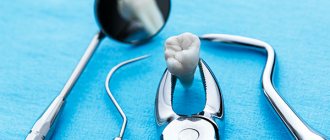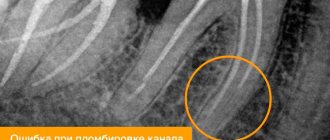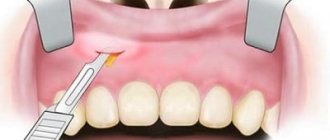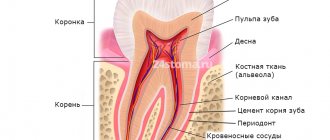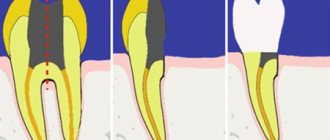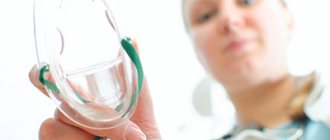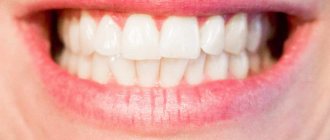Tooth extraction is carried out plannedly, as well as for emergency indications.
The main indications for planned tooth extraction: complete or severe destruction of the tooth crown and the inability to use it for prosthetics, chronic periodontitis that is not amenable to conservative treatment, grade III tooth mobility in periodontal diseases, and others.
Urgent tooth extraction is indicated for purulent periodontitis, acute osteomyelitis, periostitis, sinusitis, lymphadenitis (if the source is a diseased tooth), fracture of the tooth crown exposing the pulp and some other diseases and conditions.
Removing various teeth has some of its own characteristics, for example, removing teeth with a crown is somewhat simpler than removing tooth roots. The extraction technique for the teeth of the upper and lower jaws, incisors and molars is also slightly different.
What instruments are used to remove teeth?
Dental forceps have been and remain tools for removing teeth. For certain groups of teeth, a different type of forceps is used, since our teeth have different structures and are located differently in the dentition. For example, to remove the upper anterior tooth and the maxillary canine, there are straight forceps, and the remaining upper teeth are removed using S-shaped ones. The incisors of the lower jaw are pulled out using forceps curved at 90º with narrow cheeks (the part of the forceps that grasps the crown or root of the tooth being removed). The fangs and the two teeth following them are pulled with forceps, on the contrary, with wide cheeks. To remove large molars of the lower jaw, forceps with spikes that go between the roots are used.
Installation of an implant in the area of tooth 1.4 with bone grafting
The implant, as expected, is in a clear position for tooth 1.4; it can be seen that it stands exactly in the center of the socket.
Then we place the bone graft
— xenograft BIOS. An excellent bone material that will allow us to maintain the volume of bone tissue and prevent it from collapsing and losing the volume of soft tissue.
At the same time, while the clinic was making a temporary crown for us, a gum former
so that the bone graft lies “calmly”:
What is the typical tooth extraction process like?
When teeth are removed, local anesthesia is first administered. The doctor then removes about half a centimeter of gum tissue from the tooth. Then forceps are applied to the crown of the tooth being removed. When removing teeth in the upper jaw, the doctor presses on the forceps with his entire right hand. When removing teeth on the lower jaw, pressure is applied with the thumb of the right hand. The tooth is then dislocated to destroy the tissue that holds it in place. To remove single-rooted teeth, such as front teeth, rotational or pendulum-like movements are performed. When removing molars, pendulum-like movements are performed. The culmination of this action is the tooth extracted from the hole.
Installation of a temporary crown
On the same day, 1 hour after installation of the implant, the patient was fixed with a temporary crown
:
We see it in the chewing projection. We see the shaft where the screw fixation
this temporary crown. The crown is clearly in the right position.
And this is what the temporary crown looks like in the lateral projection. The installed tooth looks very natural; just above it we see traces of a fistula on the gum of the tooth, from which pus had previously leaked. The wound from the fistula, as I said earlier, was washed and treated according to the protocol.
The patient was very pleased. Yes, the situation was not pleasant, but we successfully dealt with it.
How is a complex tooth extraction performed?
Complex wisdom tooth extraction is considered to be a case when the tooth cannot be removed with the simple application of forceps. As a rule, in such situations, access to the root of the tooth being removed is first created by cutting the mucous membrane and periosteum. Complex tooth extraction with an oblique or horizontal position is carried out in parts, for which a laser or a special saw is often used. You should not be afraid of this, since cutting a hard-to-reach tooth only shortens the time of its removal. After the procedure, the doctor smoothes the sharp edges of the bone wound, washes it with hydrogen peroxide or furatsilin, the mucoperiosteal flap is placed in place and fixed with sutures.
In complex cases, tooth extraction surgery does not have a uniform technique. How the doctor will act depends on the specific case.
Root removal
How is the root of a tooth removed if the tooth is completely destroyed? Despite this situation, extraction is not always recommended. If, after diagnosis, the doctor determines that the root can be used for an inlay, then the tooth is restored with a crown. But if there is pain, an unpleasant smell and taste, or swelling has developed, then dental care is required urgently. In this case, the question of whether to remove the roots of the teeth is decided in favor of the operation, since the neglected condition can also lead to the loss of neighboring elements.
Regardless of the chosen technique, pain relief and X-ray control are required after removal. This allows you to make sure that there are no root fragments in the cavity, since it is often loose and can crumble under slight pressure from the forceps.
When is complex tooth extraction indicated?
Tooth extraction is considered difficult due to tumor or edema, periodontitis, periodontitis, abscess and gumboil. The presence of a cyst and a fistulous tract in the tooth also complicates the removal procedure. Impacted (unerupted) teeth are also indications for surgical tooth extraction. Complex cases include the removal of a dystopic wisdom tooth located outside the dentition; removal of 4 teeth to correct malocclusion; removal of baby teeth in children at an early age. Severe curvature of the roots and fracture of the apical part of the root are also indications for surgery. Please note that complex tooth extraction is not performed during pregnancy.
The method in which your tooth will be removed depends on the individual case. Only a specialist can determine the removal strategy. In any case, you should not be afraid of this procedure. A competent doctor will perform the removal correctly, and all you have to do is say “thank you”
Stages of the procedure
First, the dentist must conduct a diagnostic examination, examining the root of the tooth and the patient’s oral cavity. Particular attention is paid to the condition of the gums and the presence of inflammation. A survey and medical history allows you to choose the best method of anesthesia that will not cause an allergic reaction.
Then the doctor, based on the condition of the tooth root, selects the extraction method and prepares the instrument to be used.
An injection with an anesthetic is made into the gum in the area of the affected tooth root, and further procedures to remove the root using the chosen method are carried out after the anesthesia has taken effect.
After the tooth root is removed, the oral cavity is treated with an antiseptic, then an anti-inflammatory agent is applied to the treated area. If an incision was made in the gums, it is necessary to apply sutures. They are removed after a week. After tooth root removal, the patient is prescribed analgesics and antibiotics.
Now - the stage of prosthetics of the upper front teeth
In this photo you can see the fixation of temporary crowns
on previously installed Straumann implants. It can be seen that the crowns have settled exactly as they were originally. As you remember, we decided to use the patient's old crowns as temporary crowns.
screw-retained
temporary crowns
. The shafts extend exactly to the back surface of the teeth, as pre-planned in the computer program.
You can see what the patient received on the day of the operation, namely:
on the day of the operation the patient left with her teeth!
And almost no one around you will notice that any surgical procedures have been performed. The patient looks exactly the same as she came BEFORE the immediate implantation surgery.
Temporary crowns for the front teeth, as you can see in the photo, we left the old ones.
Since the accuracy of implantation was very high, i.e. Straumann implants were positioned in the bone, I would say, with filigree precision, so there was no need to make additional temporary prostheses. Here I would just like to note to readers of the article
, those who are planning implantation and surgery - do not worry about the fact that if your front teeth are implanted in the frontal area, you will have to walk without teeth for some time.
No, that's not true. After the operation, you will leave with your teeth on the same day
.
Final picture of the result of implantation and prosthetics
You can clearly see how the Straumann Bone Level implants stand and how deep they are.
Both implants and temporary structures (crowns) cost exactly as needed. They were delivered exactly as planned, which gives a positive result. And it gives us all the prerequisites that the result of a one-step implantation of the front teeth, performed by doctors of the German Implantology Center, will be highly aesthetic and durable. And it will delight our patient for many, many years.
Operation procedure
The standard (simple) scheme for removing the upper tooth includes the following measures:
- a medical history examination, during which the surgeon makes sure that the patient has no contraindications to the operation;
- referring the patient for an X-ray examination and subsequent study of the resulting images;
- injection of local anesthetics;
- detachment of the gums adjacent to the enamel using a smoothing iron or a rasp;
- grasping the diseased tooth with the cheeks of dental forceps and dislocating it by rocking or rotating around an axis;
- extraction of teeth and movable bone fragments from the alveolus;
- sanitation of the alveolar socket (tissue treatment with antiseptic and anti-inflammatory agents, removal of cystic neoplasms, granulomas, etc.);
- suturing (if necessary).
Simple extraction is carried out in cases where the dental crown is well visualized, and the surgeon has the ability to securely grasp it with the cheeks of dental forceps. In case of incomplete eruption of the tooth, its increased fragility, the absence of its crown part, as well as significant curvature of the tooth roots, surgical (complex) removal is performed. In this case, the doctor can cut the gums, drill out bone tissue, divide the crown into lobes and take other measures designed to facilitate the procedure of removing the upper incisor, canine, molar or premolar from the alveolus.
Contraindications to the procedure
You should temporarily avoid deleting:
- with a decrease in blood clotting, which was caused by taking medications or the onset of menstruation;
- after suffering a hypertensive crisis, heart attack, infectious diseases;
- with severe heart rhythm disturbances;
- during gestation (if there are serious indications, surgical intervention is allowed in the second trimester).
If a patient has hemophilia or mental disorders, the operation is performed only in an inpatient setting.
Postoperative care
After the operation is completed, the surgeon books the patient for a preventive examination and dressing, prescribes anti-inflammatory, antihistamine, antibacterial and painkillers. In addition, the doctor explains to the patient how to properly care for the postoperative wound. In particular, the surgeon may recommend:
- refuse food for 3 hours after surgery;
- ensure that the wound surface is not injured when chewing food, rinsing the mouth, brushing the teeth with a brush, floss or toothpick, etc.;
- refrain from hot drinks, alcohol, cigarettes, excessively salty, sweet, hard or spicy foods for 3 days after the procedure;
- Avoid physical activity, visiting a bathhouse or solarium for a week.
The appearance of heavy bleeding or purulent discharge from the alveolar socket, the development of inflammatory processes and severe pain in the postoperative wound area are signs of complications of the procedure. If they are identified, it is necessary to contact the surgeon who performed the operation and undergo comprehensive treatment according to the scheme drawn up by him.
We will relieve you of toothache quickly and without discomfort.
Preserving natural teeth is the primary task of dentists.
However, there are cases when removal cannot be avoided. In this situation, all the nuances are important for the successful outcome of the operation, including which jaw the tooth is located on.
Removal of teeth of the upper and lower jaw differs in the choice of instruments and the method of performing the operation. The reason is the different arrangement of teeth, their shape and root system.
Anatomical features largely influence the complexity of the case. It is believed that the upper teeth are easier to remove.
The cost of tooth extraction starts from RUB 1,600.
* Cost calculation is made after drawing up a preliminary treatment plan in accordance with the clinical case. Calculate the cost
Cost of removal when installing braces
The price of the procedure consists of several indicators: the complexity of the surgical procedures, the duration of the operation, the number of elements removed, the type of anesthesia, and the cost of drugs. For example, extracting an incisor will cost less than a premolar and at least half as much as a figure eight. General anesthesia also increases the price of the service.
In our dental clinic, you can remove several teeth at once under sedation or anesthesia. This is an absolutely safe and painless treatment. We always strive to preserve the integrity of the dentition. We have dentists of various specializations who, in difficult cases, will hold a consultation to make the right decision. The cost of treatment and removal is discussed with the patient before the procedures begin.
Possible complications
Among the most common complications that occur during tooth root removal are the following:
- dislocation of the jaw, if the doctor has little experience;
- inflammatory process in the hole;
- penetration of bone particles into it;
- damage to teeth located next to the one being removed;
- allergy to anesthesia;
- heavy bleeding.
If you do not skimp on dental services and contact an experienced specialist, as well as follow all medical recommendations, then the risk of complications is minimized.
Contraindications
Before removing a tooth from above, the doctor conducts a diagnosis, identifying the presence of contraindications in the patient. If a person has acute infectious inflammation, the acute phase of mental illness, diabetes mellitus, systemic diseases of the heart muscle or poor blood clotting, extraction is not performed. It is not indicated in the first and last months of pregnancy, when women begin their periods. If contraindications are identified, the surgeon postpones the operation to a more favorable moment.
